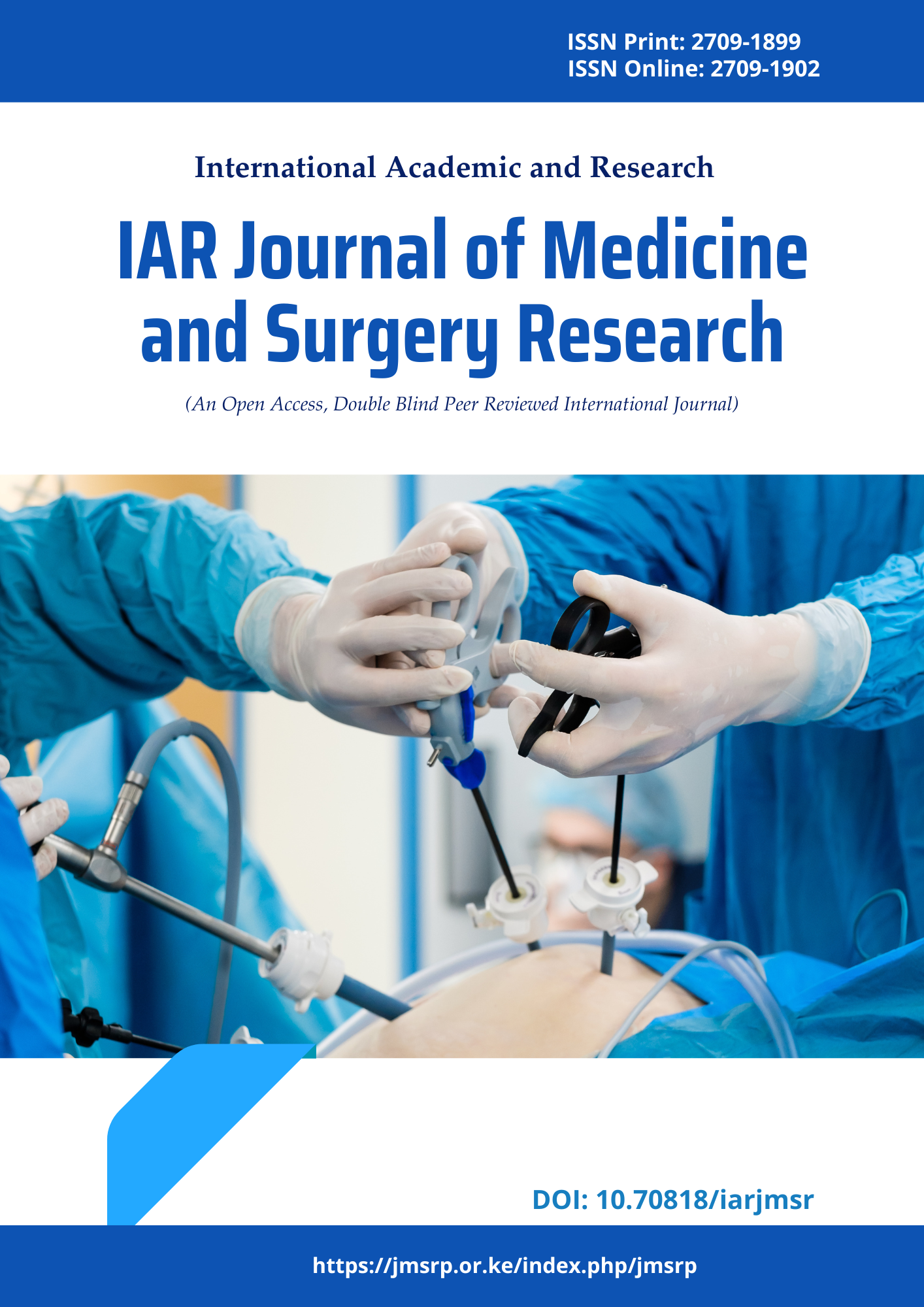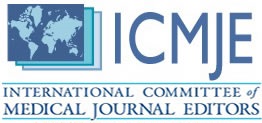Determinants of Premature Rupture of Membrane (PROM) and Feto Maternal Outcome in a Tertiary Care Hospital of Bangladesh
DOI:
https://doi.org/10.70818/iarjmsr.2025.v06i01.0155Keywords:
PROM, Feto-Maternal Outcome, Obstetrics and GynecologyAbstract
Background: Premature rupture of membranes (PROM) affects 4% to 10% of full-term pregnancies globally. PROM accounts for roughly one third of all preterm births. Aim: To find out the feto-maternal outcome of Premature Rupture of Membrane with it’s risk factors. Methods: It was a hospital based prospective study conducted in the Department of Obstetrics and Gynecology in Dinajpur Medical College & Hospital, Dinajpur. Study participants were 50 admitted patients with Pre-mature Rupture Of Membrane (PROM) in the Obstetrics and Gynecology Department. Data was collected by a checklist and structured Bangla questionnaire and analysis was done by using SPSS version 20. Results: Majority of PROM patients belonged to the age group 21-24 years which was 19 (38.0%). The mean (±SD) age of the patients was 26.04±5.2 years. A total of 35 (70.0%) patients delivered within 24 hours of rupture of membrane and 9 patients (56.2%) had past history of MR or abortion, 3 (18.8%) had history of PROM in previous pregnancy. A total of 23 (46.0%) cases had sexual contact within 1 week of rupture of membranes. E.Coli was the most common pathogen 5 (41.7%) associated with positive High vaginal Swab (HVS) culture. Majority of the patients 31 (62.0%) developed labour pain within 12 hours of PROM. Sixteen (32.0%) patients developed morbidity included puerperal sepsis, UTI, PPH, wound dehiscence, and retained placenta. APGAR score at 5 minutes was >7 in 30 (60%). Out of 47 alive babies- 19 (40.4%) were affected by the consequences of PROM and birth process. Among them asphyxia was more common 7 (35%) than other morbidities. Total 10 of them required admission in neonatal ward and most of the morbidity of the newborn appeared within 1 to 3 days of delivery. Conclusion: Early identification and management of PROM can reduce negative feto-maternal outcomes. Key risk factors including sexual intercourse, maternal health issues (like urinary tract and sexually transmitted infections), and previous obstetric history were explored. More randomized controlled trials with larger samples are needed for definitive insights.
References
Enjamo, M., Deribew, A., Semagn, S., & Mareg, M. (2022). Determinants of Premature Rupture of Membrane (PROM) Among Pregnant Women in Southern Ethiopia: A Case-Control Study. International journal of women's health, 14, 455–466. https://doi.org/10.2147/IJWH.S352348.
Gibbs, R., Karlan, B., Haney, A. and Nygaard, I. (2008). Danforth’s Obstetrics and Gynecology. 10th Edition, Lippincott Williams & Wilkins, Philadelphia.
William, N.P., Beckmann, M.D. (2007). Obstetrics and Gynecology. 7th ed. Lippincott Williams & Wilkins,
Sarkar, M., Mondal, T., & Sarkar, M. (2021). PROM and it’s maternal outcome: a retrospective study in a rural medical college of India. International Journal of Reproduction, Contraception, Obstetrics and Gynecology. 27;10(6):2379.
Griff Jones; Pre labour rupture of the membrane; Obstetrics &Gynaecology-An evidenced based text for MRCOG; Arnold, Member of the hodder headline group.www.arnold publishers.com; 1st edition; Oxford University press; 2004; p297.
Sultana, J & Chowdhury, T.A. & Khan, M.H. & Begum, K. (2005). Amniotic fluid index values after preterm premature rupture of the membranens and subsequent perinatal infections. Bangladesh Journal of Obstetrics and Gynecology. 20 (2), 51-55.
Zahan, U.N., Nigger, M. N., & Akter, S. (2023). Premature rupture of membrane - Evaluation of incidence and risk factors in a tertiary Medical College Hospital. Bangladesh Critical Care Journal, 11(2), 109–112. https://doi.org/10.3329/bccj.v11i2.69185
Shah, S. R., Patel, A. H., Doshi, H. U., Sindhav, G., Verma, R., Mehta, A. V., Raval, B. M., Vaghela, R. B., & Jadhav, A. R. (2023). A study of feto-maternal outcome in case of premature rupture of membrane at a tertiary care center. International Journal of Reproduction, Contraception, Obstetrics and Gynecology, 12(2), 441–444. https://doi.org/10.18203/2320-1770.ijrcog20230131.
Ashley, S., Roman, M.D. & Martin L. P. (1994). Late pregnancy complication, Current obstetric gynaecologic diagnosis and treatment, 8th edition. Appleton & Lange, 286-87
Mercer, B.M., Gibson, K.S. (2023). Premature (prelabor) rupture of the membranes. In: Lockwood CJ, Copel JA, Dugoff L, et al, eds. Creasy and Resnik's Maternal-Fetal Medicine: Principles and Practice. 9th ed. Philadelphia, PA: Elsevier; chap 39.
Khan, A., Imran, N. F., & Khan, A. (2024). Review of Feto-Maternal Outcome in Patients with Premature Rupture of Membranes at Term. Journal of Saidu Medical College Swat, 14(2), 105–108. https://doi.org/10.52206/jsmc.2024.14.2.855
Mercer, B. M., Miodovnik, M., Thurnau, G. R., Goldenberg, R. L., Das, A. F., Ramsey, R. D., Rabello, Y. A., Meis, P. J., Moawad, A. H., Iams, J. D., Van Dorsten, J. P., Paul, R. H., Bottoms, S. F., Merenstein, G., Thom, E. A., Roberts, J. M., & McNellis, D. (1997). Antibiotic therapy for reduction of infant morbidity after preterm premature rupture of the membranes. A randomized controlled trial. National Institute of Child Health and Human Development Maternal-Fetal Medicine Units Network. JAMA, 278(12), 989–995.
Ahmed, E. M. O. M. S., Algaily, B., Jaber, M. H. (2024). Maternal and Fetal Outcome in Actively Managed of PROM at Elhasahisa Teaching Hospital 2020. Int J Clin Med Edu Res, 3(2), 01-05.
Nelson, L. H., Anderson, R. L., O'Shea, T. M., & Swain, M. (1994). Expectant management of preterm premature rupture of the membranes. American journal of obstetrics and gynecology, 171(2), 350–358. https://doi.org/10.1016/s0002-9378(94)70034-6
Yeasmin, M. S., Uddin, M. J., Biswas, R. S. R., Azdar, A., Chowdhury, S., & Nourin, N. A. (2020). Risk Factors of Premature Rupture of Membrane in A Tertiary Care Hospital, Bangladesh. Chattagram Maa-O-Shishu Hospital Medical College Journal. Nov 1;19(2):5–8.
Sarkar, M., Mondal, T. and Sarkar, M. (2021). PROM and it’s maternal outcome: a retrospective study in a rural medical college of India. International Journal of Reproduction, Contraception, Obstetrics and Gynecology. 10. 2379. 10.18203/2320-1770.ijrcog20212179.
Akter, S., Akther, R., Rashid, M. (2010). Preterm Prelabour Rupture of the Membrane &Feto-Maternal outcome: an Observational Study. Journal of Bangladesh College of Physicians and Surgeons Vol. 28, No. 1, 17-23.
Allen S. R. (1991). Epidemiology of premature rupture of the fetal membranes. Clinical obstetrics and gynecology, 34(4), 685–693. https://doi.org/10.1097/00003081-199112000-00004.
Romero, R., Emamian, M., Quintero, R., Wan, M., Hobbins, J., Mazor, M., & Edberg, S.C. (1988). The value and limitations of the Gram stain examination in the diagnosis of intraamniotic infection. American journal of obstetrics and gynecology, 159 1, 114-9.
Mousiolis, A., Papantoniou, N., Mesogitis, S., Baglatzi, L., Baroutis, G., & Antsaklis, A. (2012). Optimum mode of delivery in gestations complicated by preterm premature rupture of the membranes. The journal of maternal-fetal & neonatal medicine: the official journal of the European Association of Perinatal Medicine, the Federation of Asia and Oceania Perinatal Societies, the International Society of Perinatal Obstetricians, 25(7), 1044–1049. https://doi.org/10.3109/14767058.2011.614659
Ghafoor S. (2021). Current and Emerging Strategies for Prediction and Diagnosis of Prelabour Rupture of the Membranes: A Narrative Review. The Malaysian journal of medical sciences: MJMS, 28(3), 5–17. https://doi.org/10.21315/mjms2021.28.3.2
Cox, S. M., Williams, M. L., & Leveno, K. J. (1988). The natural history of preterm ruptured membranes: what to expect of expectant management. Obstetrics and gynecology, 71(4), 558–562.
Downloads
Published
Issue
Section
License
Copyright (c) 2025 Mst Shabrin Akhter, Siddika Sultana, Smrity Haque, Mohammed Faisal Alam (Author)

This work is licensed under a Creative Commons Attribution 4.0 International License.















